Last week I read a story about – no kidding – the 850 year old skeleton of a woman whose teeth were recently examined alongside other specimens in the same cemetery in Germany.
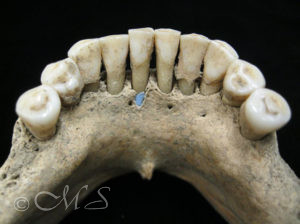
According to the story in the journal Science Advances, scientists like to poke around in very old dental skeletal calculus to find evidence of food, bacteria, and other remains that harden over time.
In this specific case, what they found instead of plaque and tartar was a remarkable chunk of rare lapis lazuli pigment, embedded in the skeleton’s lower jaw behind her front teeth.
Further study has now determined that the reason for the existence of this fragment of pigment was that she was very likely a scribe who created, painted, and copied lavishly decorated sacred illuminated manuscripts right along with the guys. According to the article, the discovery may represent the sole surviving evidence of “female scribal activity” in the area.
Dazzling Beauty But Very Costly

The most brilliant lapis is found in one of the most remote places in the world, Badakshan Province, Afghanistan. This presents another possible clue to the story; in Medieval times, lapis was likely imported from this remote area to many places in the world, including Germany where this woman/skeleton lived and worked.
The pigment was as costly as gold, and would have been used by highly skilled scribes of renown and was certainly not available to ordinary artists and scribes. Still today, it can cost many hundreds of dollars per gram for a superior grade of dazzling beauty.
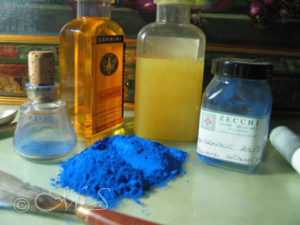
As you know, I have used lapis blue in my paintings for many years and find the history behind this pigment particularly interesting. While in Florence, Italy in 2003, I purchased several grams at Zecchi’s Belle Arte and carefully horde it for special paintings.
In 2006/07, I not only used the pigment but also hand-made the paint for my Lessons from the Low Countries project, and later for Lessons from the Pharaoh’s Tomb Part I and Lessons from the Pharaoh’s Tomb Part II.
The images below show my use of lapis blue in my paintings.
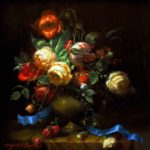
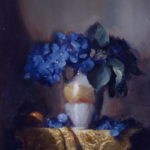
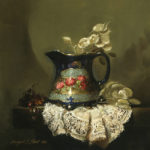
So How Did the Pigment Get in Her Teeth?
Throughout my painting years, I have personally observed many fellow artists chewing on their paint brushes, which might explain how the piece of lapis lazuli ended up in the mouth of this skeleton.
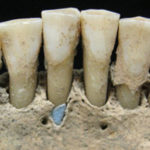 Picture an artist in a thoughtful moment, wondering where to place the next stroke and absentmindedly inserting a paintbrush handle into their mouth.
Picture an artist in a thoughtful moment, wondering where to place the next stroke and absentmindedly inserting a paintbrush handle into their mouth.
Perhaps it was by this method that a blue pigment particle was left behind, not to be discovered for 850 years!
It’s Never too Late for a Little Respect!
Scribes who worked during the Medieval period rarely signed their own work, so it is very difficult to determine who created the manuscript illuminations which featured this rare pigment, but there is plenty of documentation about another such scribe/author, Christine de Pisan. She was born in France in 1364 and throughout her long life she wrote novels, poetry, biography, literary, and political commentary to support her family after her husband died. In addition, she was one of the first women to write about women’s equality.
Perhaps now with this new discovery of the 850 year old skeleton, women artists’ contributions to the art world will be given a more notable and visible standing in history.
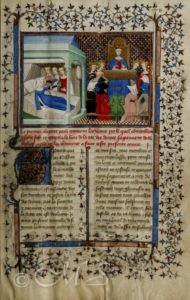


Dear Margret,
Thank you for your informative and eye opening discussion.
I have had my eyes opened to the beauty of your work at Gallery 903 and am always delighted to see new works on exhibit there.
I met you once and appreciated the time you took to explain and ellaborate on your work to this novice.
Hello Janice, Thank you for your very nice comment. It is gratifying to know you found this topic informative and perhaps beneficial to your own work. The more we can each observe and delve into the understanding of painting, the more fun it is to actually do it. Though I am not a novice, I never stop learning. The fun is in the hunt, so to speak. Keep searching. Best, Margret
I admire your ability as an artist. I appreciate the way you teach. For me your written reflections create a window for me to use to look deeper into your paintings. That deeper look is like having the pleasure of reading a favorite novel without the sorrow of an ending. Thank you.
Well, coming from a former teacher, that is a compliment for sure. I do consider my writing about art a way of teaching and hopefully initiating a deeper meaning of it all. Thank you for your nice thoughts.